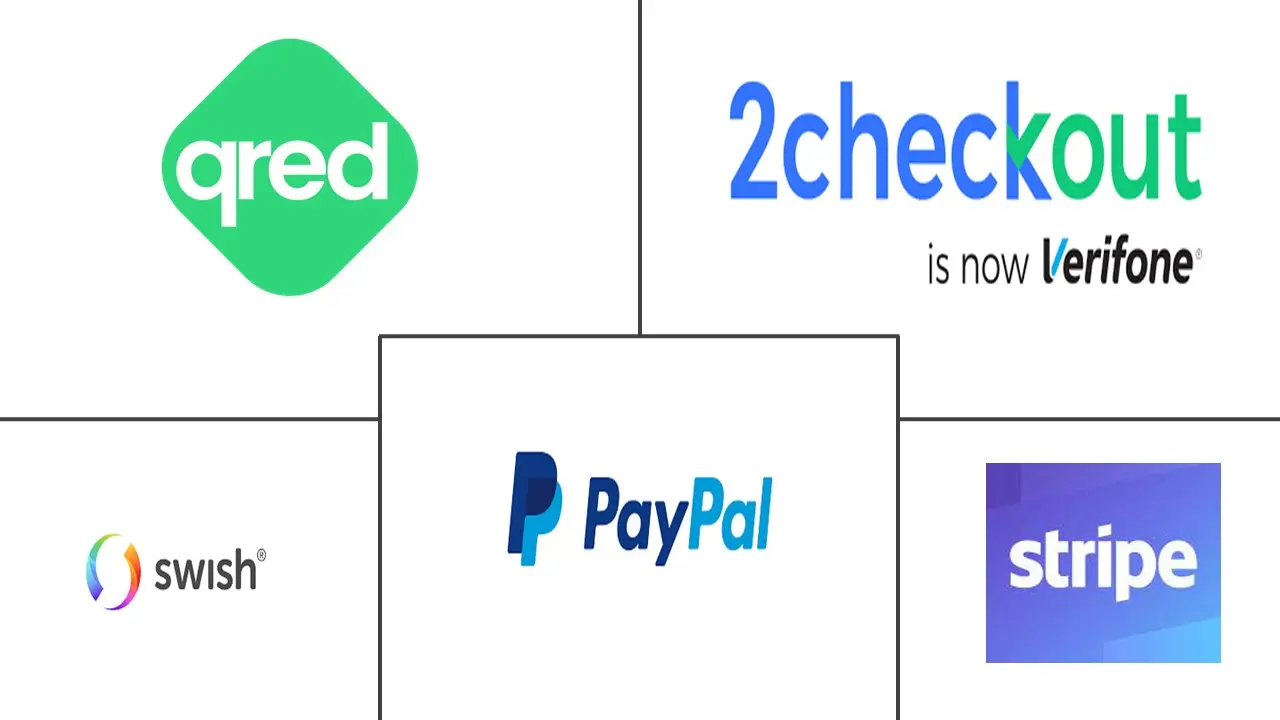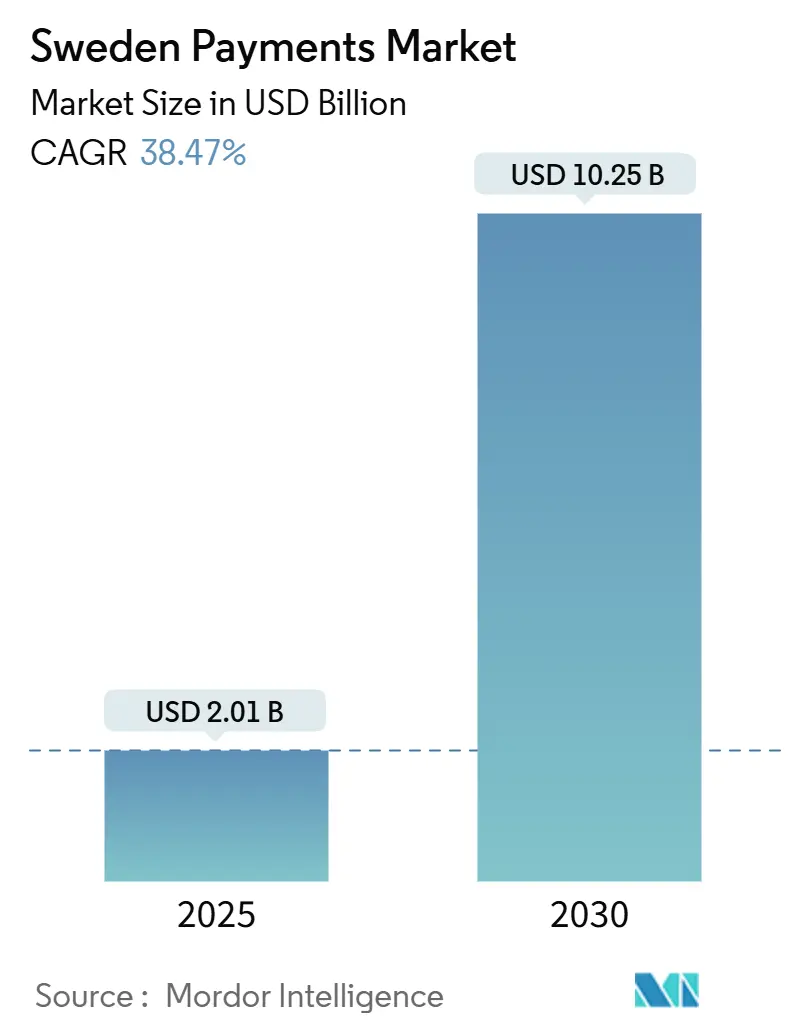
Sweden Payments Market Analysis by Mordor Intelligence
The Sweden payments market is valued at USD 2.01 billion in 2025 and is projected to rise to USD 10.25 billion by 2030, reflecting a robust 38.47% CAGR. Sustained growth comes from near-universal mobile-internet coverage, high smartphone ownership, and consumers’ clear preference for swift, low-friction payment journeys. Continuous investment in 5G and fiber networks accelerates real-time authorizations, while tight collaboration between banks and fintechs shortens time-to-market for novel services. The Riksbank’s e-krona program signals strong central-bank support for a cash-lite economy, strengthening public confidence in digital rails. Competition is intensifying as global card schemes, account-to-account specialists, and local wallet providers race to integrate value-added services such as buyer protection, installments, and loyalty.
Key Report Takeaways
- By interaction channel, point-of-sale commanded 55% of Sweden payments market share in 2024, while e-commerce / m-commerce is forecast to expand at a 40.2% CAGR to 2030. Overall Point-of-Sale led with 59% revenue share.
- By transaction type, consumer-to-business held 60% of the Sweden payments market size in 2024; person-to-person payments are advancing at a 44.6% CAGR through 2030.
- By mode of payment, POS cards captured 33% of Sweden payments market share in 2024, whereas online digital wallet & account-to-account payments are set to grow at a 42.1% CAGR.
- By end-user industry, retail led with 50% revenue share in 2024; healthcare is projected to expand at a 43.1% CAGR to 2030.
Sweden Payments Market Trends and Insights
Drivers Impact Analysis
| Driver | (~) % Impact on CAGR Forecast | Geographic Relevance | Impact Timeline |
|---|---|---|---|
| E-commerce proliferation & cross-border shopping | +9.6% | National, Nordic spillover | Medium term (2-4 years) |
| Swish penetration catalysing A2A retail payments | +8.5% | National | Short term (≤ 2 years) |
| Riksbank e-krona pilot | +6.9% | National | Long term (≥ 4 years) |
| Merchant adoption of SoftPOS & tap-to-phone | +5.8% | National, urban hubs | Medium term (2-4 years) |
| Nordic interchange caps on micro-tickets | +4.6% | Nordic region | Medium term (2-4 years) |
| Embedded-finance checkout in Swedish SaaS | +3.1% | National | Medium term (2-4 years) |
| Source: Mordor Intelligence | |||
E-commerce Proliferation & Cross-Border Shopping Driving Higher Digital Spend
Card share is slipping as shoppers turn to local wallets and “pay-by-bank” options for their international baskets. Fifty-eight percent of Swedish consumers bought from overseas merchants in 2024, mainly in China, Germany, and the UK. Payment-orchestration layers that auto-route to the most efficient rail have gained traction among the 31,588 webshops powered by WooCommerce and Shopify. Consolidated checkout stacks lower abandonment and raise authorization rates, supporting sustained growth in the Sweden payments market.
Swish Penetration Catalysing A2A Retail Payments
Swish acceptance rose to 300,000 merchants in 2024, up 18% year-on-year, and 95% of adults now hold the app.[1]Getswish AB, “About Swish,” Getswish, swish.nu The February 2024 link to the Eurosystem TIPS rail lets domestic banks clear kronor instantly across Europe.[2]European Central Bank, “Sweden Joins TIPS – Eurosystem Instant Payments Platform,” European Central Bank, ecb.europa.eu Resulting speed and reliability position account-to-account as a credible rival to cards at checkout, reinforcing real-time expectations in the Sweden payments market.
Riksbank E-krona Pilot Strengthening Confidence in a Cash-Lite Future
Phase 4 focuses on offline functionality so users can pay when networks fail.[3]Sveriges Riksbank, “Payments Report 2025,” Sveriges Riksbank, riksbank.se Only 10% of in-store purchases still involve cash, underscoring structural demand for a digital equivalent of notes and coins. Close alignment with the EU digital-euro agenda may grant Swedish citizens seamless use across borders, further enlarging the Sweden payments market.
Merchant Adoption of SoftPOS & Tap-to-Phone in SME Segment
Half of Swedish micro-merchants prefer funds settled straight to their bank accounts. Turning Android or iOS devices into terminals eliminates hardware rentals and lowers total cost of acceptance. Uptake mirrors the 51% share of consumers who already make in-store purchases via mobile phones, accelerating omnichannel convergence.
Restraints Impact Analysis
| Restraint | (~) % Impact on CAGR Forecast | Geographic Relevance | Impact Timeline |
|---|---|---|---|
| Rural cash dependency among 70+ & differently-abled users | –3.8% | National, rural skew | Medium term (2-4 years) |
| Rising fraud in push-payment & BNPL | –5.8% | National | Short term (≤ 2 years) |
| High network fees on corporate purchasing cards | –3.1% | National | Medium term (2-4 years) |
| Limited interoperability of QR schemes | –2.7% | National, cross-border | Medium term (2-4 years) |
| Source: Mordor Intelligence | |||
Rising Fraud in Push-Payment & BNPL Transactions Eroding Trust
Social-engineering scams drove losses past SEK 1 billion (USD 0.1 billion) in H1 2024. Regulators propose tougher reimbursement rules and stronger authentication, but criminals exploit real-time rails’ irrevocability. Providers now deploy behavioural biometrics and AI fraud scoring to restore confidence, a prerequisite for healthy expansion of the Sweden payments market.
Limited Interoperability Between National QR Schemes & EU-Wide Solutions
The European Payments Initiative launched the Wero wallet in 2024 to interconnect local QR codes. Until Swedish schemes map to this standard, tourists and cross-border merchants face clunky work-arounds, dampening adoption potential.
Segment Analysis
By Mode of Payment: Digital Wallets Reshaping Online Transactions
Online digital wallet and account-to-account payments are forecast to grow at 42.1% CAGR, solidifying their role in daily spending. Overall Point-of-Sale led with 59% revenue share. A 2024 survey found 39% of Swedes favor pay-by-bank for essential purchases. POS cards still contribute 33% of Sweden payments market size in 2024, but their share is eroding as biometric authentication and tokenized wallets make mobile checkouts faster.
Growth in digital wallets leans heavily on e-commerce merchants integrating Swish and BankID. Cash usage slipped to 10% , while niche form factors such as wearables and QR codes attract early adopters. The 2024 TIPS integration gives wallets instant cross-border reach, reinforcing long-term gains for this segment.
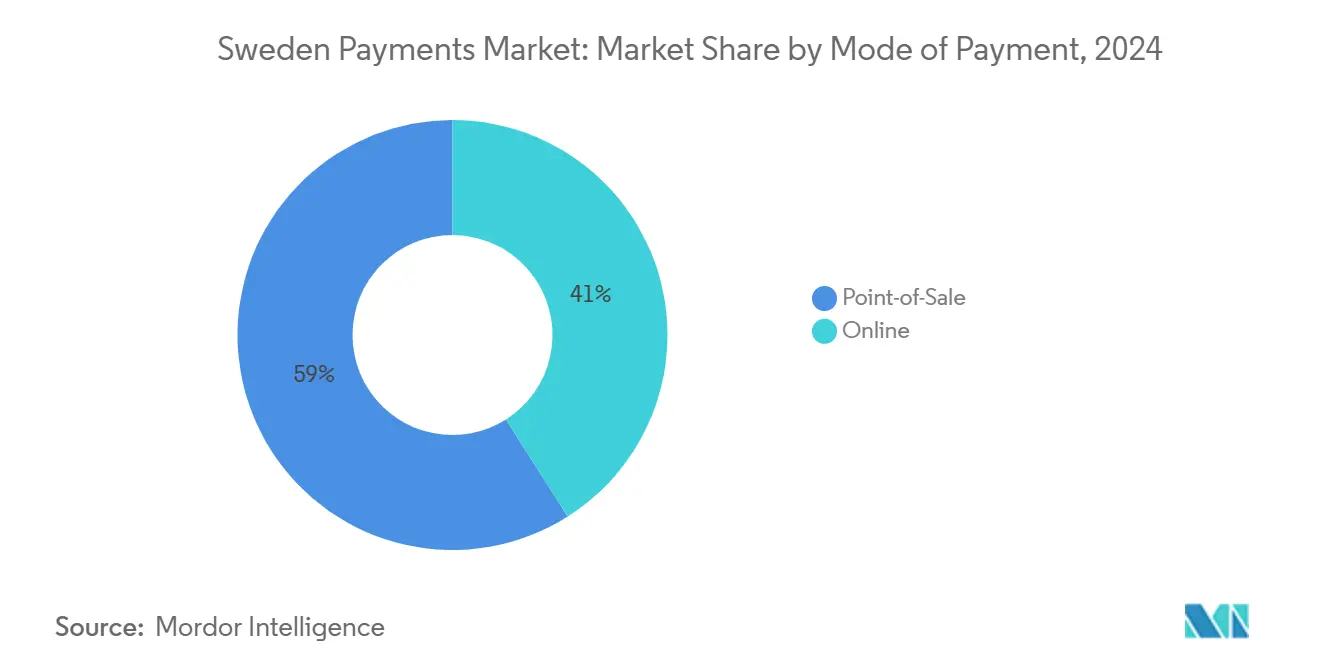
By Interaction Channel: Mobile Commerce Driving Digital Transformation
Mobile and desktop commerce together are expected to rise at a 40.2% CAGR, outpacing in-store volumes. Mobile wallets account for half of online checkouts and are growing 14.1% annually. Meanwhile, point-of-sale remains the largest channel with a 55% share of Sweden payments market share in 2024, yet is modernising quickly through contactless acceptance.
Omnichannel APIs now unify fraud controls and settlement across physical and online stores. The Riksbank notes that 50% of shoppers already tap phones in-store, blurring lines between channels. Retailers that overlay loyalty and real-time inventory gain incremental margin and stickier customers.
By Transaction Type: P2P Payments Revolutionizing Personal Transfers
Person-to-person flows are projected to climb 44.6% CAGR through 2030, powered by Swish processing more than 1 billion transactions in 2023. Consumer-to-business maintains a 60% share of Sweden payments market size, but increasingly leverages P2P rails to cut card fees for micro-ticket merchants.
Business-to-business adoption lags due to legacy ERPs and high interchange on corporate cards. Open-banking mandates are spurring vendors to embed account-to-account pay-outs and reconciliation, which should raise efficiency in procurement cycles.
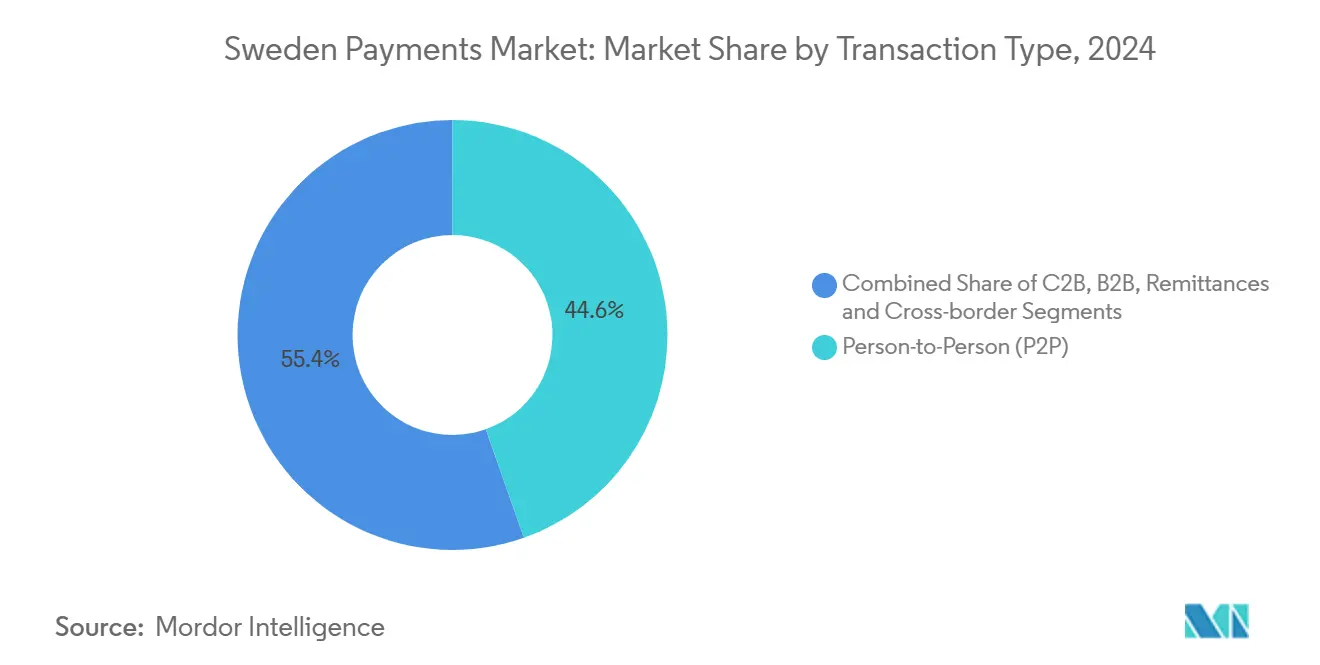
Note: Segment shares of all individual segments available upon report purchase
By End-User Industry: Healthcare Digitalization Accelerates Payment Innovation
Healthcare payments are forecast to expand at 43.1% CAGR as clinics integrate instant pay-ins with electronic patient records. European Health Data Space rules encourage common standards, accelerating the shift to paperless invoicing.
Retail still commands 50% of 2024 revenue in the Sweden payments market, yet omni-checkout, loyalty wallets, and embedded financing elevate consumer expectations. Entertainment, travel, and government services are next in line for digitisation, each adding incremental volume to the Sweden payments industry.
Geography Analysis
Regional adoption is uneven. Urban areas post near-cashless metrics, while rural districts keep higher cash circulation, especially among citizens aged 70 plus. Pending legislation may oblige shops selling essentials to accept cash, underlining inclusion priorities.
Integration with the Eurosystem TIPS platform in 2024 gives Swedish banks instant clearing in kronor, simplifying trade across the EU and elevating the Sweden payments market size for cross-border volumes.
Nordic collaboration initiatives such as P27 and the Nordic Payments Council’s instant credit transfer scheme extend interoperability, promoting scale efficiencies and encouraging harmonised standards.
Competitive Landscape
Local champion Swish retains unrivalled penetration at 95% of adults 3, forming a high entry barrier for foreign schemes. Klarna leverages its checkout network to cross-sell BNPL and personal-finance tools, reporting strong Q1 2025 gains. Trustly’s March 2025 appointment as settlement partner for RIX INST underscores the value of account-to-account specialisation in capturing volume where speed and cost matter most.
Strategic alliances accelerate market reach. PPRO’s June 2024 partnership with Lunar and Swish connects international acquirers to local rails, enhancing acceptance depth. Open Payments raised EUR 3 million (USD 3.3 million) in January 2025 to scale its open-banking hub, targeting SME invoicing and subscription business cases.
Incumbent banks focus on value-added overlays such as subscription management and identity services to protect interchange income. Fintech challengers differentiate with niche vertical offerings in gaming, mobility, and creator payouts, adding diversity yet reinforcing competitive pressure across the Sweden payments market.
Sweden Payments Industry Leaders
-
Qred AB
-
Getswish AB
-
Stripe, Inc.
-
2Checkout (Verifone, Inc.)
-
PayPal Holdings, Inc.
- *Disclaimer: Major Players sorted in no particular order
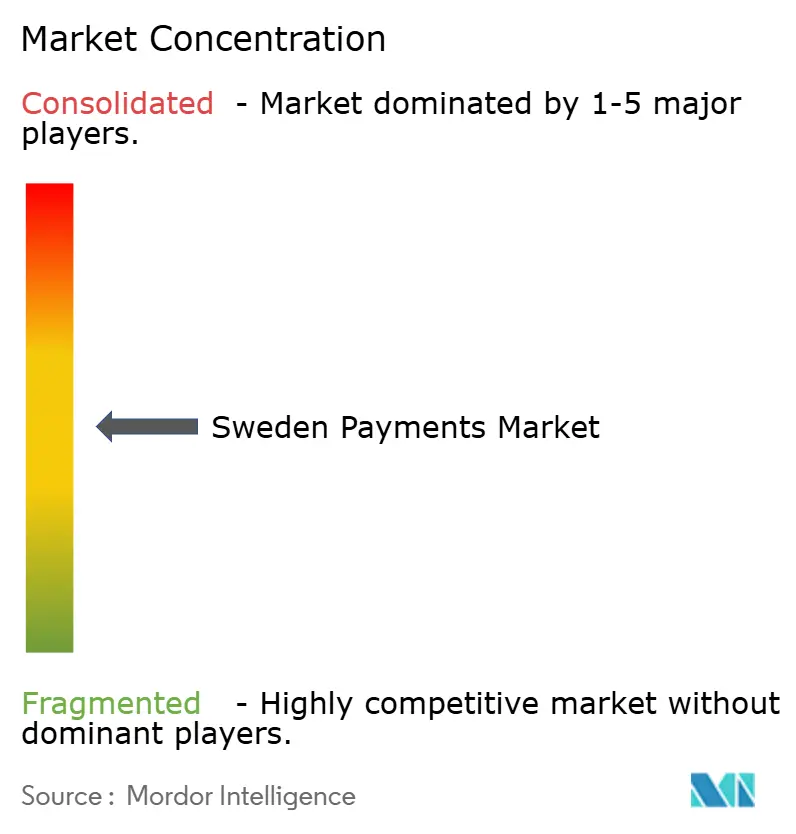
Recent Industry Developments
- May 2025: Klarna announced strong Q1 2025 growth, attributing gains to AI-driven credit scoring and expanded merchant adoption.
- March 2025: Sveriges Riksbank published its Payments Report 2025, emphasising the need for resilient offline card capability and noting that 51% of Swedes pay in store by phone.
- March 2025: Trustly became payment provider for RIX INST, enabling instant settlement for refunds and payouts across multiple banks.
- March 2025: The Riksbank confirmed an offline-card solution will be operational by July 2026 to safeguard continuity during network outages.
Sweden Payments Market Report Scope
The Swedish payment market can be divided into two payment types: POS and e-commerce. E-commerce payments include online purchases of goods and services, such as purchases on e-commerce websites and online booking of travel and accommodation. As far as POS is concerned, all transactions made at the time of physical sale are within the scope of the market, such as credit and debit card payments and more. This includes all face-to-face transactions, regardless of where they occur, not just traditional in-store transactions. Cash is also considered for both cases (cash-on-delivery for e-commerce sales).
| Point-of-Sale | Card (Debit, Credit, Pre-paid) |
| Digital Wallets (Apple Pay, Google Pay, Interac Flash) | |
| Cash | |
| Other POS (Gift-cards, QR, Wearables) | |
| Online | Card (Card-Not-Present) |
| Digital Wallet and Account-to-Account (Interac e-Transfer, PayPal) | |
| Other Online (COD, BNPL, Bank Transfer) |
| Point-of-Sale |
| E-commerce/M-commerce |
| Person-to-Person (P2P) |
| Consumer-to-Business (C2B) |
| Business-to-Business (B2B) |
| Remittances and Cross-border |
| Retail |
| Entertainment and Digital Content |
| Healthcare |
| Hospitality and Travel |
| Government and Utilities |
| Other End-user Industries |
| Segmentation by Mode of Payment | Point-of-Sale | Card (Debit, Credit, Pre-paid) |
| Digital Wallets (Apple Pay, Google Pay, Interac Flash) | ||
| Cash | ||
| Other POS (Gift-cards, QR, Wearables) | ||
| Online | Card (Card-Not-Present) | |
| Digital Wallet and Account-to-Account (Interac e-Transfer, PayPal) | ||
| Other Online (COD, BNPL, Bank Transfer) | ||
| Segmentation by Interaction Channel | Point-of-Sale | |
| E-commerce/M-commerce | ||
| Segmentation by Transaction Type | Person-to-Person (P2P) | |
| Consumer-to-Business (C2B) | ||
| Business-to-Business (B2B) | ||
| Remittances and Cross-border | ||
| Segmentation by End-user Industry | Retail | |
| Entertainment and Digital Content | ||
| Healthcare | ||
| Hospitality and Travel | ||
| Government and Utilities | ||
| Other End-user Industries | ||
Key Questions Answered in the Report
What is the current value of the Sweden payments market?
The Sweden payments market stands at USD 2.01 billion in 2025 and is projected to reach USD 10.25 billion by 2030.
Which payment rail is gaining the most traction among Swedish consumers?
Swish, an instant account-to-account service, reaches 95% of adults and processes over 1 billion transactions per year, making it the fastest-growing rail.
How fast are digital wallets expanding in Sweden?
Online digital wallet and account-to-account transactions are expected to grow at a 42.1% CAGR between 2025 and 2030.
Why is healthcare the fastest-growing industry segment?
Centralised digital-health initiatives and the need for seamless billing drive a 43.1% CAGR in healthcare payment volumes through 2030.
What regulatory change will most affect payment providers in 2025?
The Digital Operational Resilience Act (DORA) takes effect in January 2025, imposing stringent IT-security and incident-reporting requirements on all financial entities.
How is fraud impacting the Sweden payments market?
Push-payment and BNPL fraud exceeded SEK 1 billion (USD 0.1 billion) in H1 2024, prompting regulators and providers to deploy AI-based detection and stronger authentication to protect users.
Page last updated on:
